
The Legion of Honor, formally known as the California Palace of the Legion of Honor, is an art museum in San Francisco, California. Located in Lincoln Park, the Legion of Honor is a component of the Fine Arts Museums of San Francisco, which also administers the de Young Museum.

Golden Gate Park is an urban park between the Richmond and Sunset districts of San Francisco, United States. It is the largest park in the city, containing 1,017 acres (412 ha), and the third-most visited urban park in the United States, with an estimated 24 million visitors annually.
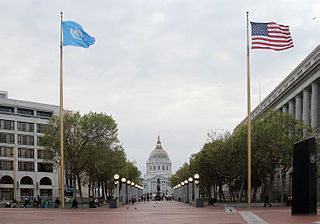
The Civic Center in San Francisco, California, is an area located a few blocks north of the intersection of Market Street and Van Ness Avenue that contains many of the city's largest government and cultural institutions. It has two large plazas and a number of buildings in classical architectural style. The Bill Graham Civic Auditorium, the United Nations Charter was signed in the Veterans Building's Herbst Theatre in 1945, leading to the creation of the United Nations. It is also where the 1951 Treaty of San Francisco was signed. The San Francisco Civic Center was designated a National Historic Landmark in 1987 and listed in the National Register of Historic Places on October 10, 1978.

Adolph Claus J. Spreckels was a major industrialist in Hawai'i during the kingdom, republican, and territorial periods of the islands' history. He also involved himself in several California enterprises, most notably the company that bears his name, Spreckels Sugar Company.

The Panama–California Exposition was a world exposition held in San Diego, California, between January 1, 1915, and January 1, 1917. The exposition celebrated the opening of the Panama Canal, and was meant to tout San Diego as the first United States port of call for ships traveling north after passing westward through the canal. The fair was held in San Diego's large urban Balboa Park. The park held a second Panama-California exposition in 1935.

The San Francisco Maritime National Historical Park is located in San Francisco, California, United States. The park includes a fleet of historic vessels, a visitor center, a maritime museum, and a library/research facility. Formerly referred to as the San Francisco Maritime Museum, the collections were acquired by the National Park Service in 1978. The San Francisco Maritime National Historical Park was authorized in 1988; the maritime museum is among the park's many cultural resources. The park also incorporates the Aquatic Park Historic District, bounded by Van Ness Avenue, Polk Street, and Hyde Street.
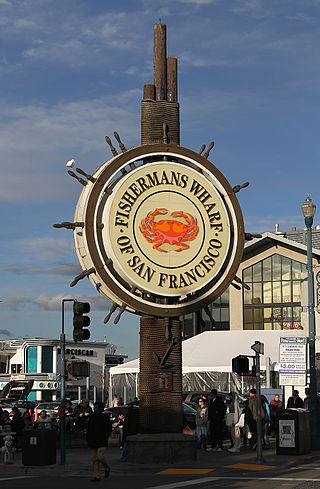
Fisherman's Wharf is a neighborhood and popular tourist attraction in San Francisco, California, United States. It roughly encompasses the northern waterfront area of San Francisco from Ghirardelli Square or Van Ness Avenue east to Pier 35 or Kearny Street. The F Market streetcar runs through the area, the Powell-Hyde cable car line runs to Aquatic Park, at the edge of Fisherman's Wharf, and the Powell-Mason cable car line runs a few blocks away.
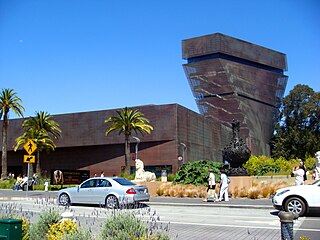
The de Young Museum, formally the M. H. de Young Memorial Museum, is a fine arts museum located in San Francisco, California. Located in Golden Gate Park, it is a component of the Fine Arts Museums of San Francisco, along with the Legion of Honor. The de Young is named for early San Francisco newspaperman M. H. de Young.

The Fine Arts Museums of San Francisco (FAMSF), comprising the de Young Museum in Golden Gate Park and the Legion of Honor in Lincoln Park, is the largest public arts institution in the city of San Francisco. FAMSF's combined attendance was 1,158,264 visitors in 2022, making it the fifth most attended art institution in the United States.

The Musée Mécanique is a for-profit interactive museum of 20th-century penny arcade games and artifacts, located at Fisherman's Wharf in San Francisco, California. With over 300 mechanical machines, it is one of the world's largest privately owned collections.
The 49-Mile Scenic Drive is a designated scenic road tour highlighting much of San Francisco, California. It was created in 1938 by the San Francisco Down Town Association to showcase the city's major attractions and natural beauty during the 1939 Golden Gate International Exposition.
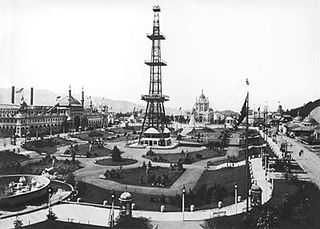
The California Midwinter International Exposition of 1894, commonly referred to as the "Midwinter Exposition" or the "Midwinter Fair", was a World's Fair that officially operated from January 27 to July 5 in San Francisco's Golden Gate Park.
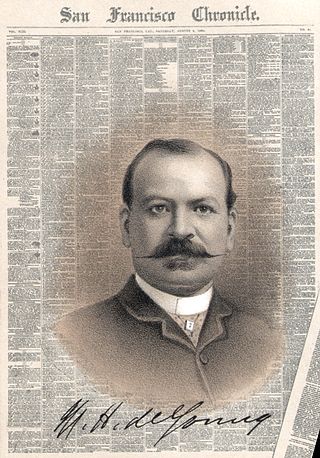
Michael Henry de Young was an American journalist and businessman.

Adolph Bernard Spreckels was a California businessman who ran Spreckels Sugar Company and who donated the California Palace of the Legion of Honor art museum to the city of San Francisco in 1924. His wife, Alma, was called the "great grandmother of San Francisco". His 1912 mansion is in Pacific Heights and is San Francisco Landmark #197.
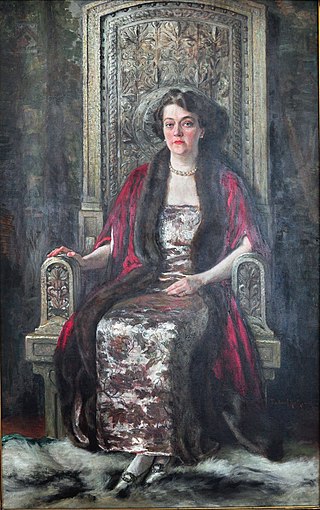
Alma de Bretteville Spreckels was a wealthy socialite and philanthropist in San Francisco, California. She was known both as "Big Alma" and "The Great Grandmother of San Francisco". Among her many accomplishments, she persuaded her first husband, sugar magnate Adolph B. Spreckels, to donate the California Palace of the Legion of Honor to the city of San Francisco.

Balboa Park is a 1,200-acre (490 ha) historic urban cultural park in San Diego, California, United States. In addition to open space areas, natural vegetation zones, green belts, gardens, and walking paths, it contains museums, several theaters, and the San Diego Zoo. There are also many recreational facilities and several gift shops and restaurants within the boundaries of the park. Placed in reserve in 1835, the park's site is one of the oldest in the United States dedicated to public recreational use. Balboa Park is managed and maintained by the Parks and Recreation Department of the City of San Diego.
Charles Peter Gabriel Moulin (1872–1945) was an American photographer. He took architectural photographs of building exteriors and interiors as well as views of San Francisco. He also took photographs of people and performances at the Bohemian Grove and was official photographer for the Bohemian Club. he photographed illustrator Harrison Fisher, sculptor Arthur Putnam, Edgar Stillman Kelley, James Thurber, and botanist Luther Burbank. His photographs are part of collections at The Bancroft Library of the University of California, Berkeley, the Oakland Museum of California, San Francisco Maritime National Historical Park and the San Francisco Museum of Modern Art.
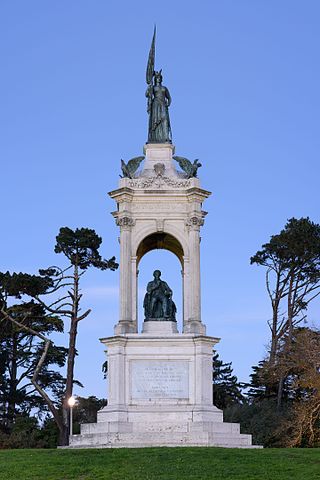
A memorial statue of Francis Scott Key stood in Golden Gate Park, San Francisco, in the U.S. state of California, from 1888 until 2020.

Spreckels Temple of Music, also called the bandshell, constructed in 1900, is in the Music Concourse at Golden Gate Park in San Francisco. It was a gift to the city from sugar magnate Claus Spreckels and is one of the largest bandshells in North America.

SkyStar Wheel is a 150-foot tall (45.7 m) 137-foot (41.8 m) diameter traveling observation wheel located in San Francisco's Fisherman's Wharf since November 13, 2023. It has previously operated in San Francisco's Music Concourse (2020–2023), Cincinnati's The Banks (2018–2020), Louisville's Waterfront Park (2018), and Norfolk (2018).





















